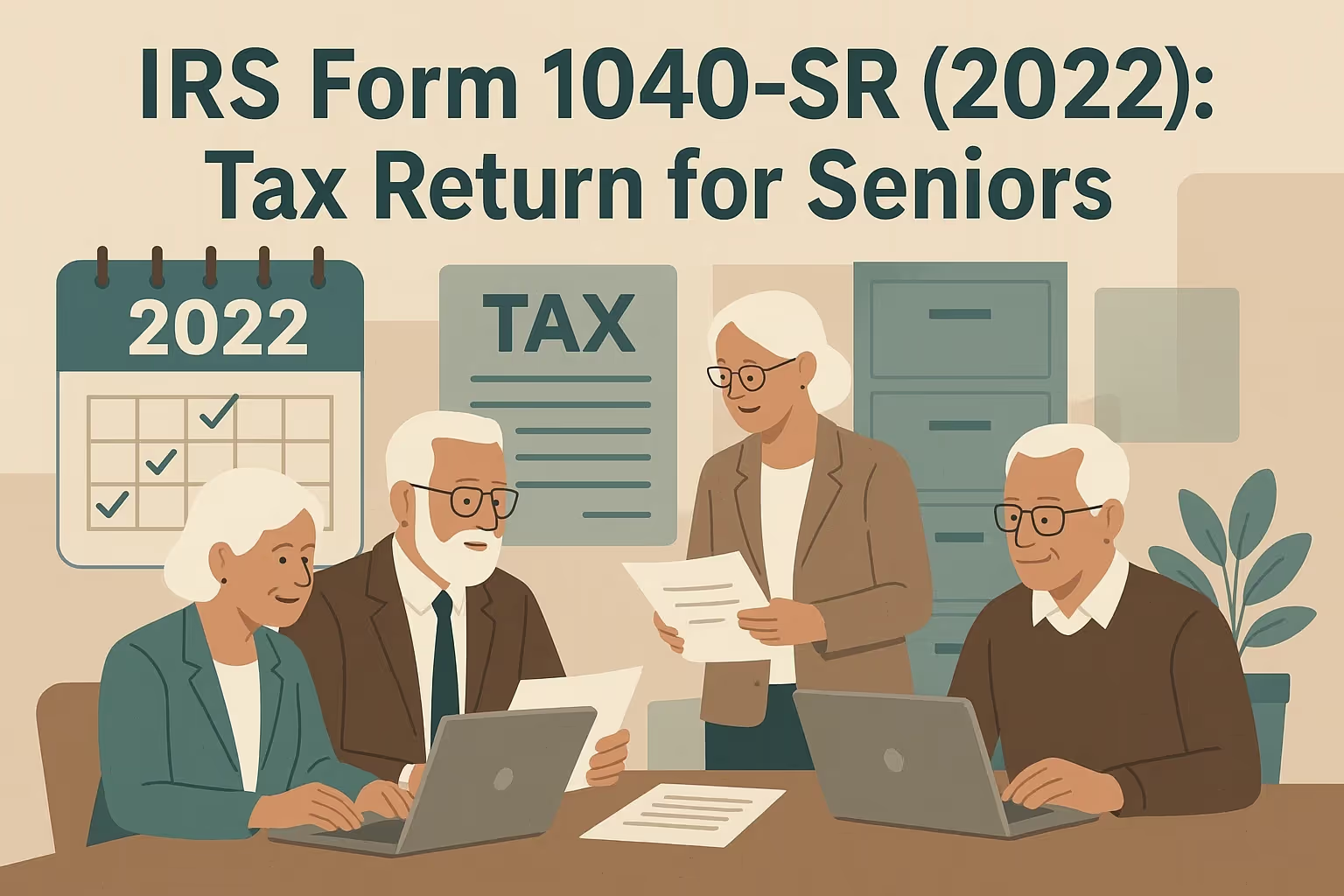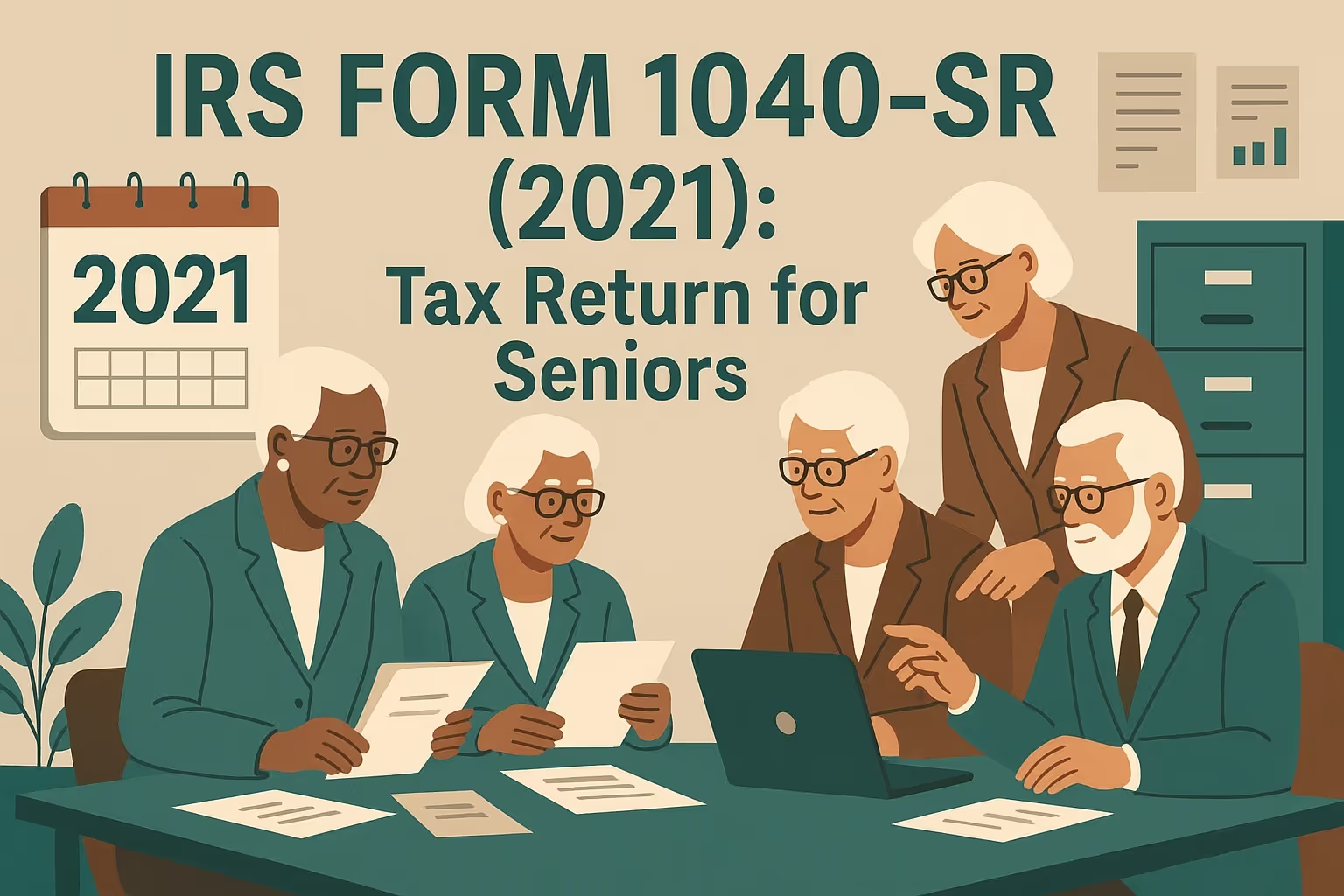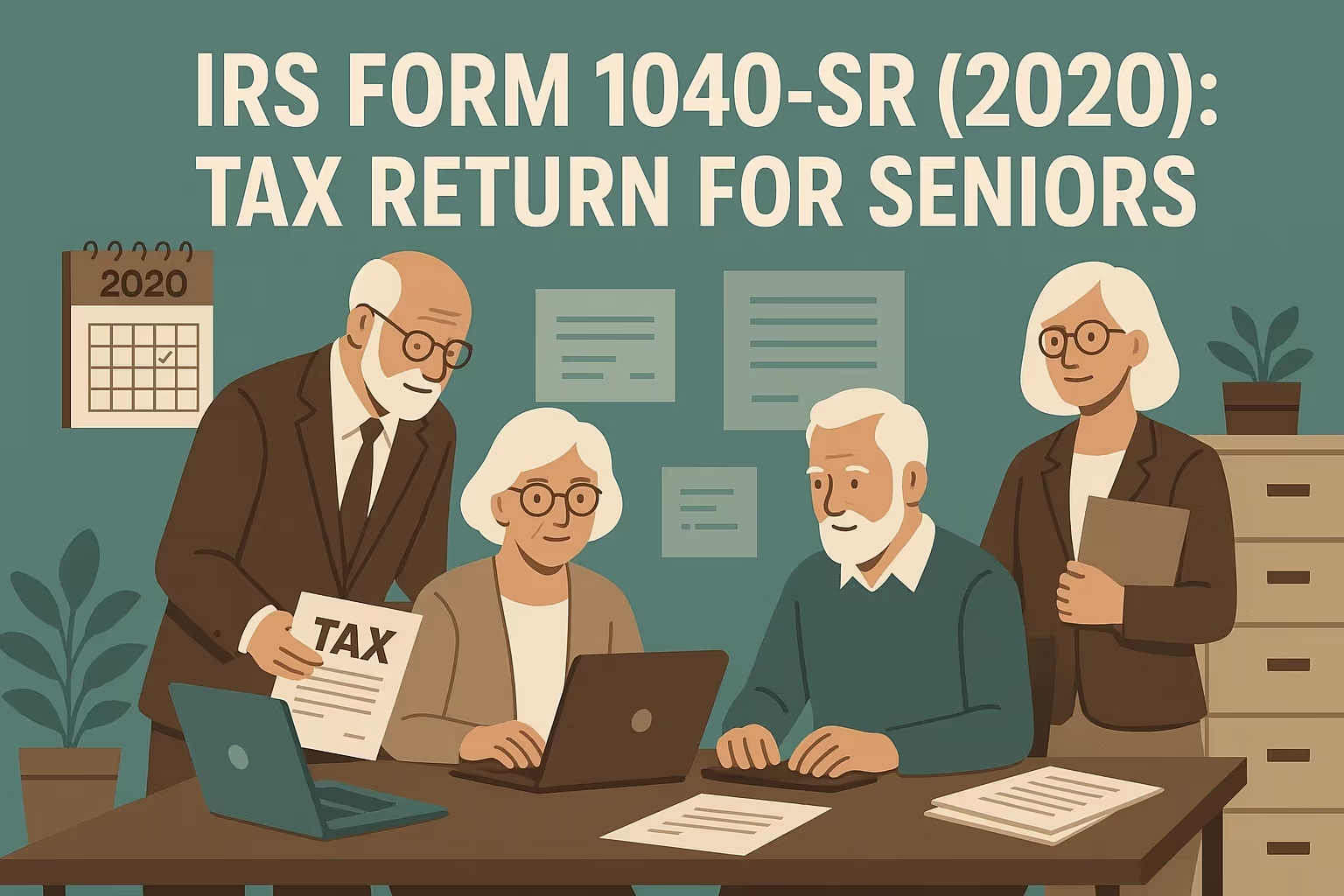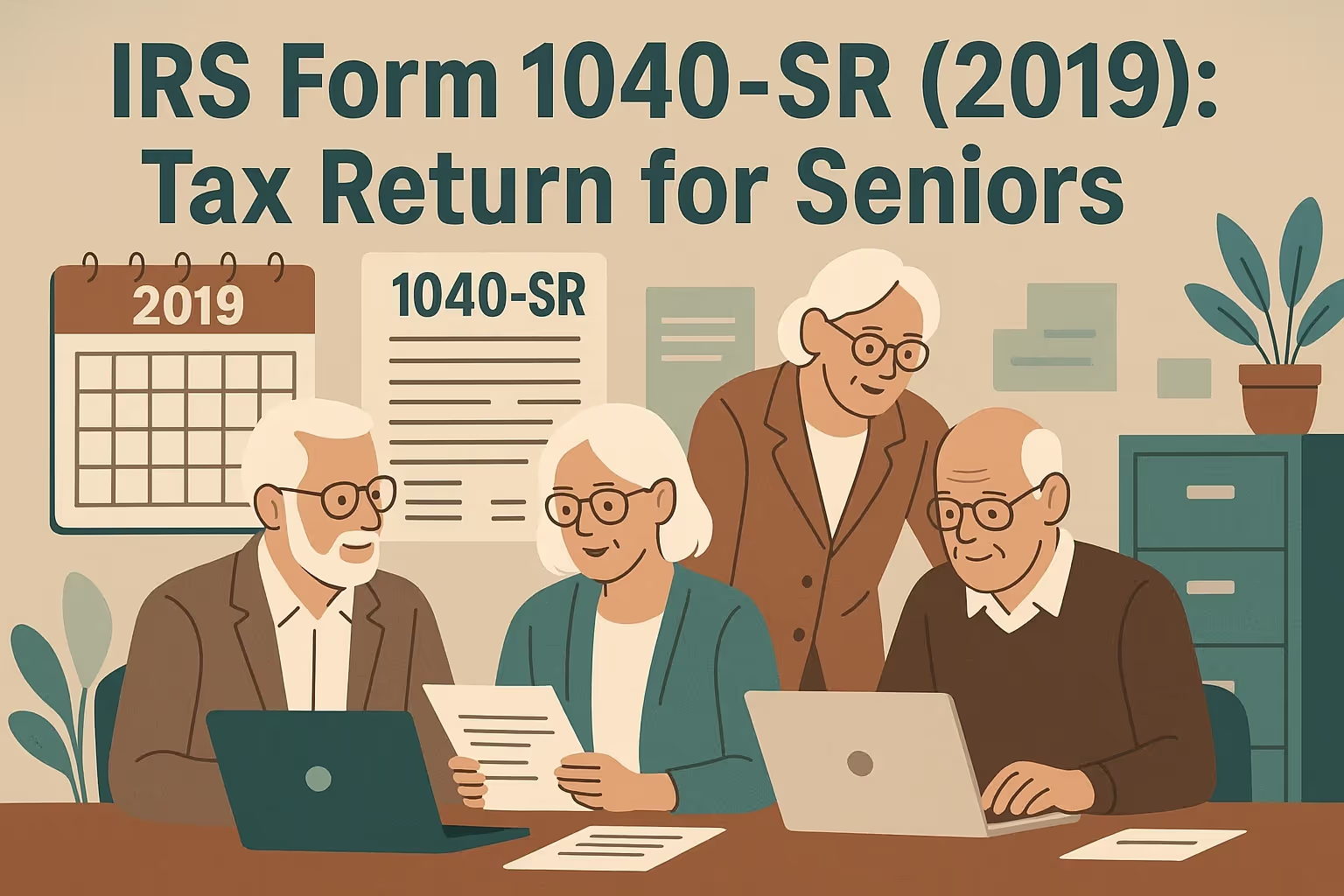Form 1040SR 2019 Instructions: Complete Guide for Seniors
The introduction of Form 1040-SR made filing a tax return for the 2019 tax year easier for seniors. This optional alternative was designed specifically for eligible taxpayers age 65 and older. The form uses the same schedules and calculations as the standard Form 1040, but its layout emphasizes clarity and larger print for better readability.
Many seniors face challenges during tax filing, especially when balancing qualified retirement plans, investment income, mortgage interest, and other deductions. The IRS recognized this difficulty and created a format that reduces visual strain while keeping the process consistent. For many, this change simplified how to prepare an income tax return while ensuring accuracy and compliance with federal requirements.
Form 1040-SR can help taxpayers file with confidence. With its built-in standard deduction chart and easier-to-read layout, seniors can complete their returns with less confusion. This guide explains the process, highlights the differences, and provides step-by-step guidance to ensure taxpayers can file correctly, claim deductions, and secure the maximum refund available.
Overview of the Form 1040SR 2019 Instructions
Understanding the basics of Form 1040-SR is essential before beginning the tax filing process. The Internal Revenue Service created this form for seniors who qualify by age but kept the underlying rules identical to Form 1040.
What Is Form 1040-SR?
- Design purpose: Created for older taxpayers with larger font and easier readability, using the same schedules and instructions as Form 1040.
- Standard deduction chart: This includes a built-in chart for deductions, simplifying the process for seniors who want a quick reference without reviewing separate documents.
- Functionality: Despite a different design, the form follows identical calculations, schedules, and forms, ensuring accuracy and compliance with IRS requirements.
- Flexibility: It remains optional, meaning taxpayers can still file Form 1040 if preferred. Both options produce the same results.
Who Can Use Form 1040-SR?
- Age requirement: Eligible taxpayers are individuals born before January 2, 1955, who were at least 65 years old by December 31, 2019.
- Joint returns: Married couples can file using Form 1040-SR if at least one spouse meets the age requirement, making it more accessible for seniors.
- Optional use: The form is not required. Seniors can still use the standard Form 1040 if they prefer that version’s structure.
- No tax difference: All calculations, credits, and deductions remain identical between forms, ensuring the choice does not affect the refund or tax owed.
What Is New for 2019 Tax Filing?
The introduction of Form 1040-SR came with other IRS changes that affected the filing process. Seniors benefit from easier formatting and updated deduction rules while following the same tax return structure.
Major Changes in Form 1040-SR
- Senior-friendly format: Larger text and spacing improved readability, reducing errors and missed details during tax return completion.
- Optional alternative form: The IRS released Form 1040-SR for older taxpayers as a new option, while maintaining the traditional Form 1040 for general use.
- Schedule simplification: The number of supporting schedules was reduced, helping seniors avoid confusion and making the filing easier.
- Retirement distributions: Pension, annuity, and IRA reporting were adjusted, giving seniors clearer instructions and better alignment of qualified retirement plans.
Standard Deduction Updates for Seniors
- Single filer: $12,200 base amount, plus an extra $1,650 for taxpayers 65 or older, raising the total deduction to $13,850.
- Married filing jointly: $24,400 base deduction, with an additional $1,300 per spouse over age 65, increasing the potential deduction to as much as $27,000.
- Head of household: $18,350 base deduction, plus $1,650 for age 65 or older, bringing the total to $20,000.
- Qualifying widow(er): $24,400 base, plus $1,300 if age 65 or older, allowing higher deductions while maintaining the same schedules as Form 1040.
Health Coverage and Other Adjustments
- Shared responsibility penalty: The penalty for not maintaining health insurance was eliminated, meaning taxpayers no longer pay a fine for lacking coverage.
- Reporting changes: IRA distributions, pensions, and annuities now appear on separate line items, helping seniors and tax experts maintain accuracy.
- Simplified schedules: Reduced from six to three, with additional income, taxes, and credits consolidated, improving how taxpayers prepare their returns.
Step-by-Step Form 1040SR 2019 Instructions
Before starting the process, taxpayers should understand that Form 1040-SR follows the same schedules and rules as Form 1040. The difference lies mainly in design and usability.
Step 1: Gather Your Documents
Collect all required forms and records to ensure accuracy when completing your income tax return. Missing paperwork can cause delays and errors.
Step 2: Choose Your Filing Status
Select the correct filing status before entering details. Seniors must evaluate eligibility based on age, marital situation, and dependent qualifications. The right choice affects deductions and tax calculations.
Step 3: Complete Personal Information
Enter names, addresses, and Social Security numbers carefully. Accuracy matters because the IRS verifies information directly with the Social Security Administration, and errors can delay processing or refunds.
Step 4: Report Your Income
Taxpayers must report income from wages, retirement distributions, Social Security, and investment income. Each type has a designated line, ensuring clarity when filling out forms and schedules.
Step 5: Calculate Deductions
Decide whether to take the standard deduction or itemize. The built-in chart on Form 1040-SR helps seniors identify amounts quickly and compare potential benefits.
Step 6: Calculate Tax
Determine the tax owed using IRS tax tables or worksheets. Seniors' calculations depend on income and filing status.
Step 7: Apply Credits
Taxpayers should review available credits, such as the Credit for the Elderly or Disabled. Depending on eligibility rules, these reduce liability and may increase refunds.
Step 8: Final Tax, Refund, or Balance Due
Add up withholdings and estimated payments. If total payments exceed tax liability, seniors qualify for a refund. Otherwise, the balance due must be paid promptly.
How to File Your Tax Return
Taxpayers can choose between electronic filing and paper filing. Each option has benefits depending on personal preference, technology access, and tax software comfort.
E-File Options
- Faster processing: Returns filed electronically are processed within weeks, ensuring eligible taxpayers receive refunds more quickly than by mailing paper forms.
- Error reduction: Built-in software checks reduce mistakes, helping seniors avoid common filing errors and ensuring accuracy throughout the process.
- Immediate acknowledgment: The IRS confirms receipt within minutes of an e-file submission, giving taxpayers confidence that their return has been received.
- Free options: IRS Free File allows eligible taxpayers to prepare and send returns electronically at no cost, depending on income limits each year.
Paper Filing
- When preferred: Some taxpayers still choose paper returns because they prefer preparing forms manually and sending physical copies directly.
- Assembly order: Attach schedules, forms, and W-2 or 1099 documents behind Form 1040-SR. Following the correct order prevents the IRS from missing information.
- Mailing addresses: Send completed returns to the designated IRS service center. Locations vary by state and whether the taxpayer includes a payment.
- Signing requirements: Taxpayers must sign and date their returns before mailing. Unsigned returns are considered incomplete and will not be processed.
Payment Instructions if You Owe
Seniors who owe money to the IRS have several secure payment options. Choosing the correct method can make the process easier and ensure timely payments are received.
Payment Options
- Direct Pay: The IRS Direct Pay service allows taxpayers to send payments directly from a bank account without additional charges or fees.
- Electronic Federal Tax Payment System: EFTPS lets taxpayers schedule recurring electronic payments, making it easier for retirees to manage taxes with predictable timing.
- Check or money order: Taxpayers may mail payments with their return. Including identifying details ensures the payment is credited correctly without delay.
- Card payments: Credit or debit card payments are accepted through third-party processors. Fees apply, so seniors should consider the cost before choosing this method.
Installment Agreements
- Eligibility: Taxpayers who cannot pay their balance in full may qualify for an installment plan by applying online or submitting Form 9465 to the IRS.
- Automatic approval: Balances under $50,000 generally qualify for automatic approval. Seniors benefit from predictable payments spread over months instead of one large amount.
- Interest charges: Even with an installment agreement, interest continues to accrue. Paying more than the minimum reduces costs over the agreement's duration.
- Application process: Taxpayers can apply online or by mail. The IRS confirms their application after reviewing their financial details and determining their monthly payment amounts.
Penalties and Interest
- Failure to pay penalty: The IRS charges 0.5% per month on unpaid taxes, which increases costs for taxpayers who delay making payments after the deadline.
- Interest on unpaid balances: Interest accrues daily on outstanding balances, making timely payment the most effective way to minimize additional financial burdens.
- Partial payments: Seniors should pay as much as possible by the deadline. Partial payments reduce both penalties and interest applied to the remaining balance.
- Missed deadlines: Ignoring deadlines can substantially increase costs. Taxpayers who miss payments may face enforcement actions, including liens or levies by the IRS.
Required Schedules and Attachments
Form 1040-SR uses the same schedules as Form 1040. Depending on their income type, deductions, and credits claimed during the tax year, seniors may need to include these.
Core Schedules
- Schedule 1: Reports additional income such as self-employment earnings, unemployment compensation, or alimony received, plus adjustments like IRA contributions or student loan interest.
- Schedule 2: Covers additional taxes, including self-employment tax, Alternative Minimum Tax, and certain penalties. Seniors with retirement distributions may also need this schedule.
- Schedule 3: allows taxpayers to claim foreign tax credit, education credit, and general business credit. Seniors sometimes qualify based on investment activities.
Other Common Schedules
- Schedule A: Used for itemized deductions like mortgage interest, state taxes, and medical expenses exceeding the threshold. Seniors should compare with the higher standard deduction.
- Schedule B: Reports taxable and tax-exempt interest or dividend income. Required when investment income is above $1,500 or involves foreign accounts.
- Schedule D: Reports capital gains or losses from selling investments or property. Seniors with investment income must review instructions carefully to ensure accuracy.
- Schedule R: Allows qualified seniors or disabled taxpayers to claim the Credit for the Elderly or Disabled, reducing overall tax liability if eligibility rules are met.
Assembly Order
- First: Place Form 1040-SR signed and dated at the front of the package.
- Second: Attach numbered schedules in sequence, ensuring none are missed when mailing or uploading.
- Third: Include lettered schedules such as A, B, D, and R behind numbered schedules.
- Fourth: Add supporting forms such as W-2s, 1099s, or other income verification documents provided by an employer or financial institution.
Common Mistakes to Avoid
Errors cause delays, missed refunds, or even penalties. Seniors should carefully review their income tax returns before sending them to the IRS for processing.
Mathematical Errors
- Miscalculated benefits: Seniors often miscalculate their Social Security taxable portions. Following IRS worksheets prevents errors and ensures accurate taxable amounts.
- Incorrect deductions: Failure to include the age-based increase in the standard deduction results in smaller refunds or higher balances owed.
- Tax table mistakes: Using the wrong line on the IRS tax table results in underpayment or overpayment, creating processing issues.
- Credit miscalculations: Errors in calculating earned income or dependent care credits reduce refunds or increase balances owed unnecessarily.
Information Errors
- Wrong Social Security numbers: Incorrect numbers for taxpayers or dependents cause rejection of returns during processing and must be corrected before acceptance.
- Misspelled names: Names must match Social Security cards exactly. Inconsistencies cause processing delays and can prevent electronic filing acceptance.
- Incorrect filing status: Choosing the wrong status changes deductions and credits, producing inaccurate results and requiring corrections later.
- Unsigned returns: The IRS rejects unsigned paper returns. Signing is required before mailing to acknowledge completion of the filing process.
Documentation Errors
- Missing attachments: Forgetting to include W-2 or 1099 forms causes the IRS to issue notices. Seniors should confirm that all income is documented and attached.
- Omitted schedules: Seniors sometimes forget required schedules, especially for investment income. This omission creates processing delays and additional correspondence.
- Foreign accounts: Seniors with foreign investments must report them. Under federal reporting requirements, missing disclosures may result in penalties.
- Health coverage forms: Some taxpayers neglect to include Form 8962 when required for premium tax credits. This error delays refunds and creates extra IRS questions.
Zero Activity or Dormant Year Guidance
Not all seniors earn taxable income each year. Depending on circumstances, rules may still require a tax return to be filed even if there is little or no activity.
When Filing Is Still Required
- Federal withholding: Seniors must file if taxes were withheld from wages, pensions, or retirement distributions to claim a refund of money already paid.
- Refundable credits: Filing may be required to claim credits such as the Earned Income Credit or Additional Child Tax Credit, even with limited taxable income.
- Self-employment income: Any self-employment earnings above $400 require a return, regardless of other income sources.
- Health insurance credits: Taxpayers who received advance premium tax credits must file a return to reconcile payments, even with limited total income.
When Filing May Not Be Required
- Single filer 65+: Filing is not required if income is below $13,850 for 2019.
- Married filing jointly: This is not required if both spouses are 65+ and have a combined income below $27,000.
- Head of household: This is not required if the income is below $20,000 when 65 or older.
- Qualifying widow(er): Not required if income is below $25,700, subject to IRS thresholds.
Benefits of Filing Voluntarily
- Refund opportunities: Filing allows seniors to recover withheld taxes even if their income is below the thresholds.
- Access to credits: Refundable credits are only available through filing a tax return, providing extra financial support for eligible taxpayers.
- Proof of income: Filed returns provide documentation often required for loans, benefits, or other financial services.
- Assurance of compliance: Filing ensures compliance and reduces the risk of IRS inquiries or questions about unreported income, even in low-activity years.
First-Time Filer Tips for Seniors
Seniors filing for the first time may find the process challenging. Taking organized steps ensures the return is complete, accurate, and submitted on time.
Getting Started
- Determine filing need: Seniors should review IRS thresholds to confirm whether a return is required. Filing voluntarily may still produce valuable refunds.
- Collect documents: Gathering W-2s, 1099s, and Social Security statements early avoids missing deadlines and allows seniors to prepare a complete return.
- Select a form: Seniors can choose between Form 1040 and Form 1040-SR. Both provide identical results, but the latter is easier to read.
- Decide filing method: Choose between e-file for faster results or paper filing for those who prefer physical forms and mailed submissions.
Expert Help and Resources
- VITA program: Volunteer Income Tax Assistance provides free preparation support for eligible seniors. Locations are available through community centers and libraries.
- TCE program: Tax Counseling for the Elderly offers specialized guidance for taxpayers age 60 and older. Trained volunteers assist with senior-specific filing needs.
- IRS tools: The IRS website offers instructions, free software, and eligibility checkers, making it easier for seniors to complete returns without missing key steps.
- Tax professionals: Seniors who prefer personalized guidance can contact a tax expert for direct assistance, especially in cases with complex income or deductions.
Record Keeping
- Copies of returns: Seniors should keep copies of filed tax returns for at least three years to support future filings or respond to IRS questions.
- Supporting docs: Keep all W-2, 1099, and deduction receipts together. Proper record keeping ensures compliance and prevents missed deductions or credits.
- Investment basis: Retain purchase records for investments. Accurate basis tracking prevents errors in reporting gains or losses when assets are sold.
- Home records: Keep documents related to property purchases or improvements. These may affect deductions or future capital gains calculations.
Frequently Asked Questions
Can I use Form 1040-SR if only one spouse is age 65 or older?
Yes, if one of the spouses qualifies by age, both can file jointly using Form 1040-SR. The form provides results identical to those of Form 1040, offering larger print and a built-in standard deduction chart. This form improves the usability of older couples completing their income tax returns accurately and confidently.
Do I need to switch if I already filed Form 1040 for 2019?
No, Form 1040 and Form 1040-SR use the same schedules, calculations, and deductions. Filing with one or the other produces identical results. Because the only distinction between the two forms is in format and presentation, taxpayers who have already submitted a tax return for 2019 are not required to make any changes to their returns or switch forms.
How do I know if my Social Security benefits are taxable?
The IRS provides worksheets in the instructions for Form 1040-SR. Generally, Social Security benefits become taxable if combined income exceeds $25,000 for single filers or $32,000 for married filing jointly. Seniors must complete the worksheet carefully, since miscalculations are a common source of errors in determining taxable Social Security income.
Should I itemize deductions or take the higher standard deduction?
Most seniors benefit from the standard deduction, especially with the additional amount available at age 65. However, seniors with high medical expenses, mortgage interest, or charitable contributions may save more by itemizing. Comparing both options is essential. The built-in deduction chart in Form 1040-SR simplifies the process for eligible taxpayers each year.
Can I e-file Form 1040-SR?
Yes, seniors can e-file Form 1040-SR using approved tax software or with the assistance of a tax expert. E-file submissions receive faster acknowledgment, reduce processing errors, and deliver refunds within weeks rather than months. This option is recommended for taxpayers who want to maximize accuracy, save time, and receive their refunds more quickly.
What should I do if I make a mistake on my return?
If an error is discovered after filing, seniors must file Form 1040-X to amend the tax return. The IRS allows three years from the original filing date to make corrections. Amended returns can correct income, deductions, or filing status. Prompt corrections ensure accuracy, reduce penalties, and prevent unnecessary IRS inquiries about incomplete or inaccurate information.


















